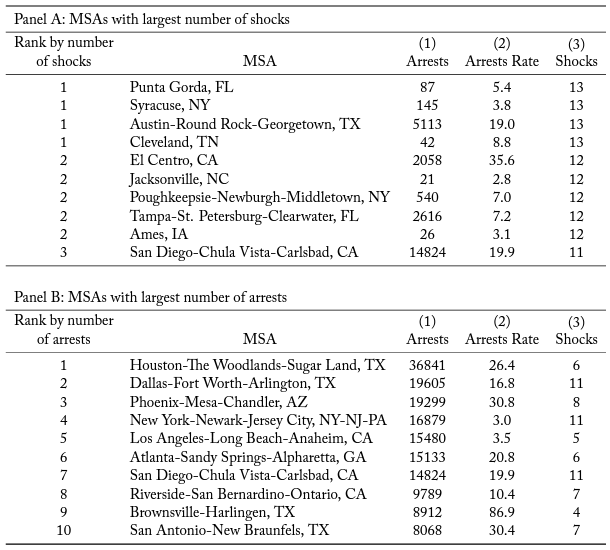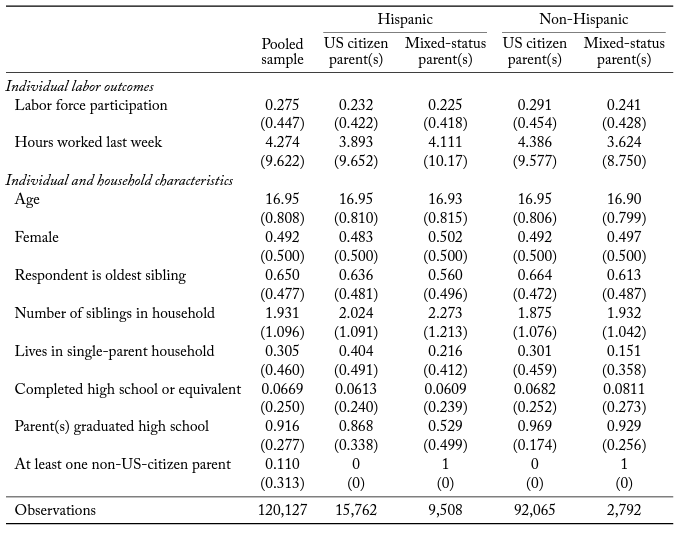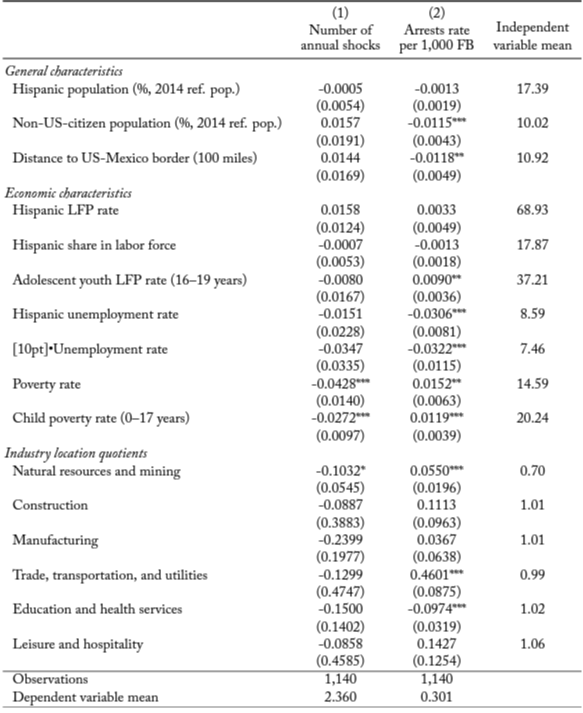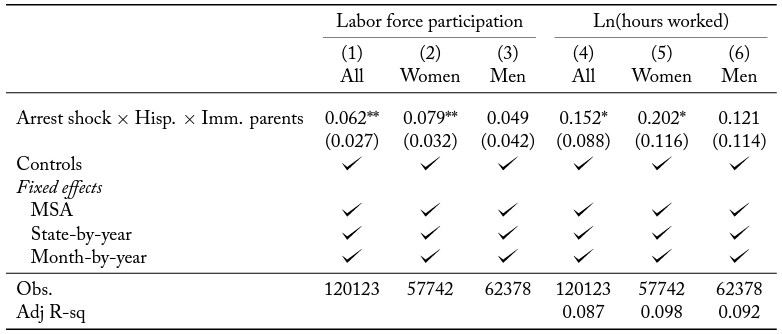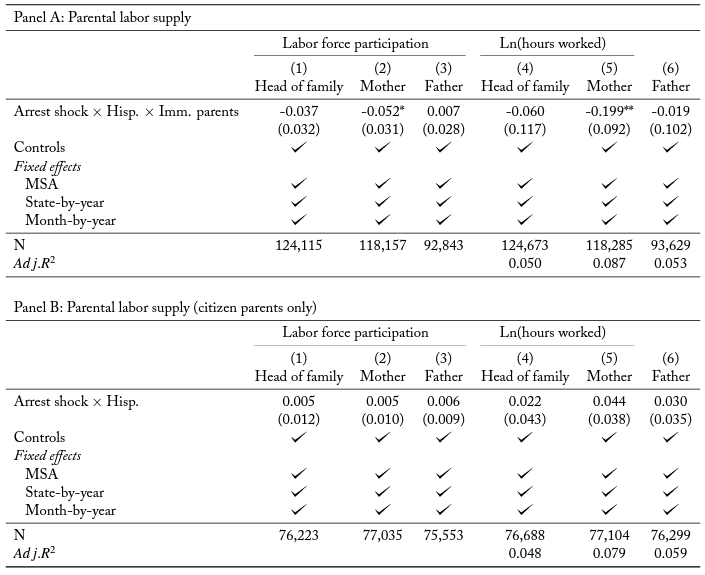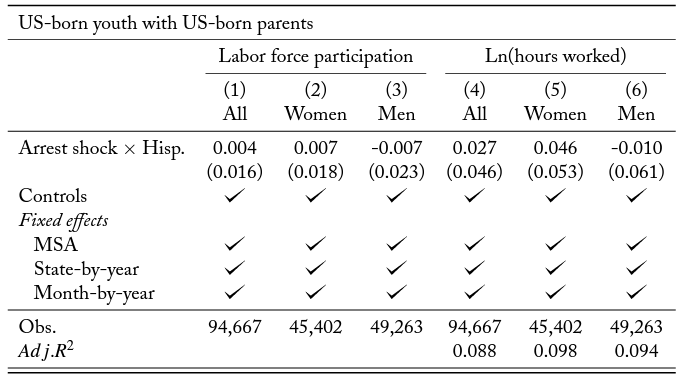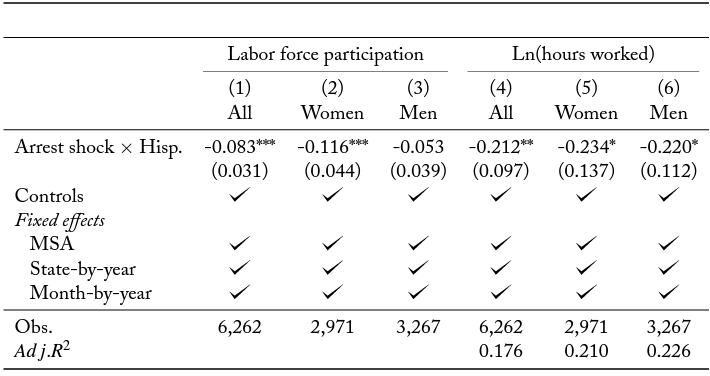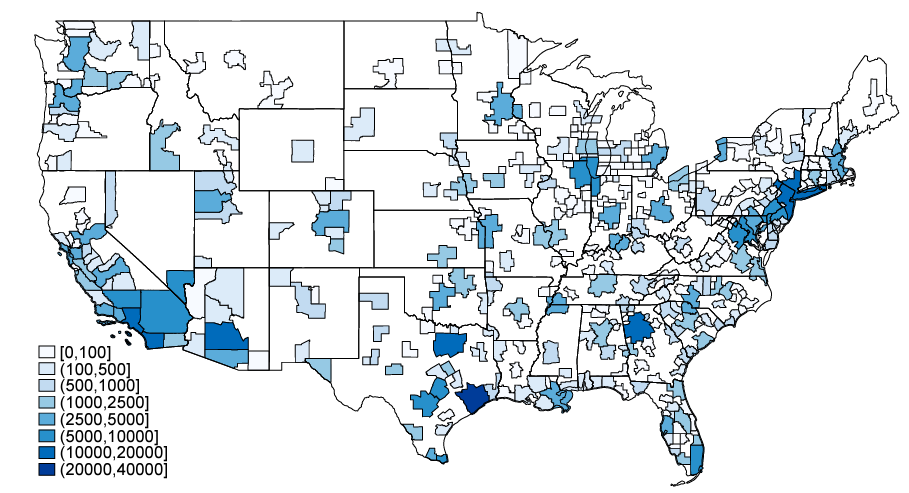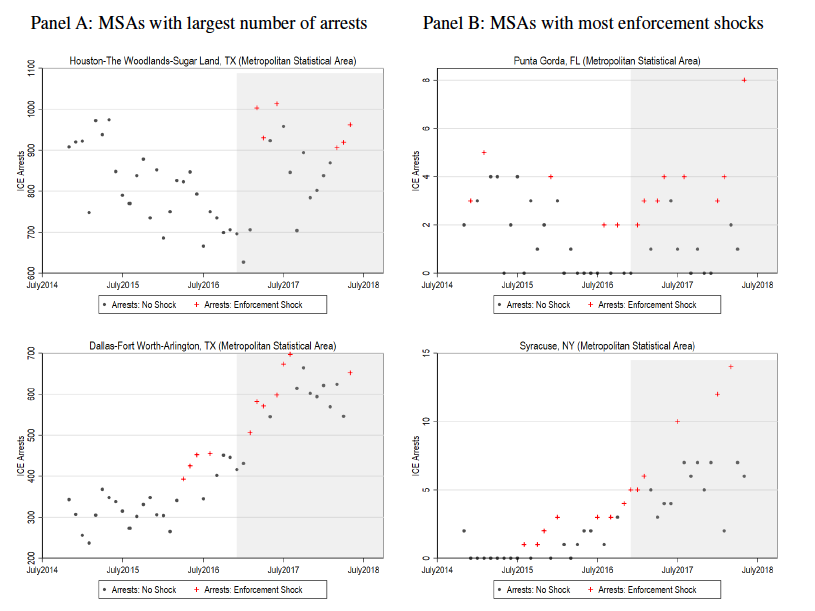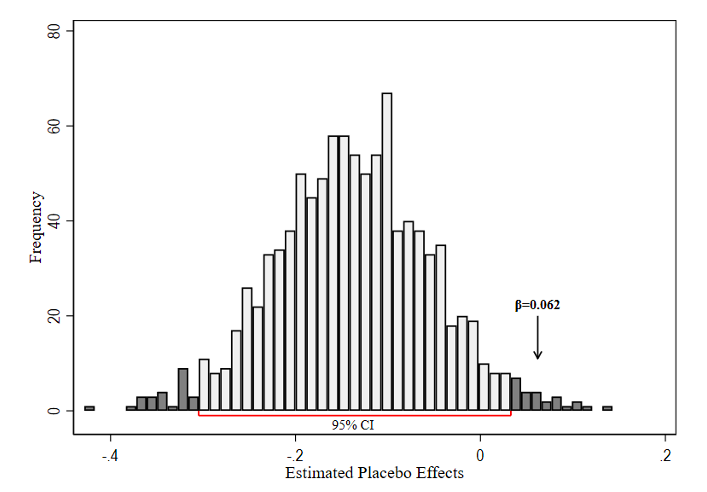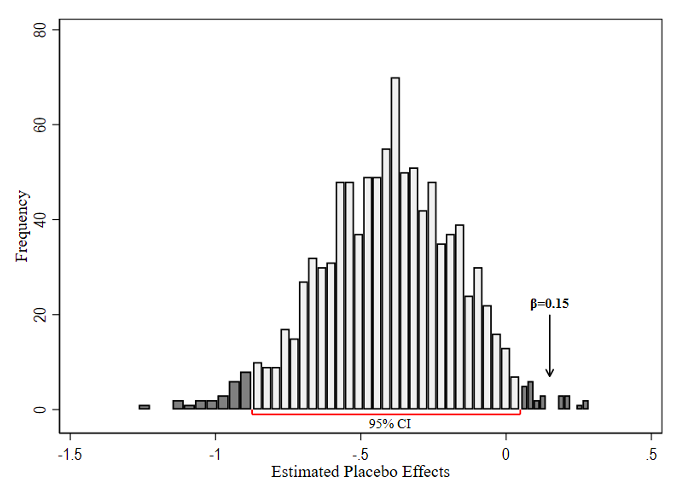Introduction
Over the past two decades, the expansion of local, state, and federal immigration enforcement policies have vastly reshaped the socioeconomic landscape for millions of immigrants in the United States and their families. The implementation of policies such as Secure Communities, 287(g) agreements, employment verification mandates (E-Verify), and omnibus immigration laws have resulted in 2 million arrests and 3.6 million deportations between 2008 and 2018 (ICE, 2015, 2018b).1Arrest count obtained from Transactional Records Access Clearinghouse (TRAC), available at https://trac.syr.edu/ immigration/reports/529/.These enforcement actions have primarily targeted Hispanic immigrants, with individuals born in Latin American countries accounting for approximately 97 percent of all deportations in recent years (ICE, 2018b). However, it is not only the foreign-born who are impacted by these policies. Between 2014 and 2018, the removal of unauthorized immigrants resulted in the deportation of over 200,000 individuals who claimed to have US-born children, placing an additional 4.4 million citizen children living with at least one unauthorized immigrant parent at risk of family separation (Capps et al., 2020).2Data obtained from ICE biannual reports to Congress on deported migrants claiming US-born children. See, for example, ICE, 2018a, available at https://www.hsdl.org/?view&did=817380. Last accessed October 2021.
Prior studies document various detrimental indirect impacts of enforcement policies on the socioeconomic well-being of US citizens. The risk of detention and deportation of immigrant family members, as well as the surge in interactions between US citizens and immigration authorities (Cantor, Ryo and Humphrey, 2019), have been found to affect US-citizens’ labor and education outcomes, poverty, political engagement, and social program participation.3For example, Amuedo-Dorantes and Bansak (2014); Amuedo-Dorantes and Lopez (2017a); Amuedo-Dorantes, Arenas- Arroyo and Sevilla (2018); Amuedo-Dorantes and Bucheli (2020); Bohn, Lofstrom and Raphael (2015); Bucheli, Rubalcaba and Vargas (2021); East and Velasquez (Forthcoming); Watson (2014).
However, there is a limit to our understanding of how US citizens living in mixed-status households may strategically respond to protect immigrant relatives from the consequences of intensified immigration enforcement.
With this paper, we begin to fill this gap in the literature by examining whether intensified immigration enforcement impacts the labor supply of citizen youth living in mixed-status families.4Following Bucheli, Rubalcaba and Vargas (2021); Xu, Pirog and Vargas (2016), we designate mixed-status families status when there is at least one US-born child living with at least one non-US citizen parent.
Our conceptual framework is motivated by the added worker effect, whereby a spell of unemployment experienced by a household member spurs an interdependent labor supply response from another member as an intra-household strategy to smooth income and consumption (Lundberg, 1985). Studies find that heightened immigration enforcement reduces unauthorized immigrants’ labor supply as a strategy to lower the risk of apprehension and deportation—in other words, the “chilling effect” documented throughout the literature (e.g., Amuedo-Dorantes and Bansak, 2014; Bohn, Lofstrom and Raphael, 2015; Orrenius and Zavodny, 2015). We contend that unauthorized immigrant parents in mixed-status families may rely on their US-born children to smooth income during periods of increased immigration enforcement. In sum, we hypothesize that citizen youth living in mixed-status households increase their labor supply to mitigate the chilling effect and potential losses in household income.
We test this hypothesis using individual-level data from the basic monthly Current Population Survey (CPS) merged with immigration-related arrests conducted in the US interior by Immigration and Customs Enforcement (ICE) agents for each month and metropolitan statistical area (MSA) during 2014–2018.
We deliberately avoid using variation in the level of ICE arrests within an MSA over time, as this would be an endogenous measure of immigration enforcement. Rather, to capture an exogenous variation in arrests, we construct an indicator variable identifying the months in which the level of arrests exceeds the
MSA-specific trend; this allows us to measure unexpected increases in local enforcement actions. Our approach differs notably from most existing studies, which examine the impact of immigration enforcement using the activation of immigration policies as the basis for a quasi-experiment—a strategy that fails to account for the de facto heterogeneity in enforcement intensity (Amuedo‐Dorantes and Antman, 2022). In contrast, the shock variable in our study captures unusual surges in immigration enforcement, even when underlying immigration policies remain unchanged.
Our empirical strategy leverages temporal and geographical variation in the arrest shock indicator to estimate the impact of heightened immigration enforcement actions on the labor supply of Hispanic citizen youth living in mixed-status families. We focus on the labor market responses of Hispanic youth to capture the highest risk of arrest exposure given the overwhelming targeting of this demographic group by immigration enforcement. Specifically, we examine the labor supply responses at the extensive (labor force participation) and intensive (weekly hours worked) margins, and we explore whether young women and men respond differently to an arrest shock. Moreover, in supplemental analyses, we document the extent to which non-citizen parents in mixed-status households adjust their labor supply when faced with unusual surges in ICE arrests. Lastly, we begin to explore some of the plausible trade-offs associated with changes in labor supply as measured by education outcomes.
Overall, we find that an unexpected increase in arrests results in higher labor supply among Hispanic citizen youth living with non-citizen parents. Indeed, an arrest shock raises labor force participation by 6 percentage points and labor hours by 15 percent. We find that young women are most responsive to the shock, with an increase in labor force participation of 8 percentage points and a 20 percent increase in labor hours. We demonstrate that our results stem from variation in immigration enforcement actions rather than changes in local economic conditions, by estimating the labor supply “effects” of immigration enforcement on a sample of citizen youth living with citizen parents. In support of our identification strategy, we find no change in the labor supply of these youth who are, in effect, unaffected by changes in immigration enforcement. Additionally, when examining the labor supply responses of non-citizen parents in mixed-status families, we find suggestive evidence of an overall decline in labor supply that is more pronounced for mothers and along the intensive margin, a finding that aligns with prior studies (Amuedo‐Dorantes and Antman, 2022). Lastly, we find suggestive evidence that youth in mixed-status households who experience unexpected increases in immigration enforcement are less likely to be enrolled in school and more likely to repeat a grade. Consistent with our labor results, we estimate larger and statistically significant impacts among the subsample of women.5Unlike the labor market effects, which appear to be contemporaneous to the shock in immigration enforcement, the impacts on educational outcomes are only economically and statistically significant when considering a cumulative exposure to immigration enforcement.
Our contributions to the literature are threefold. First, we provide a unique insight into the unintended consequences of immigration enforcement through the lens of US citizen youth in mixed-status households. The findings emphasize the pervasive nature of the US immigration enforcement strategy and are particularly striking given that citizen youth in immigrant households—one of the fastest growing demographic groups in the United States (Woods and Hanson, 2016)—may be forced to transition into adulthood prematurely. Second, our results highlight the role of intra-household labor supply decisions as a coping and protective mechanism against the detrimental effects of immigration enforcement actions on the financial well-being of immigrant households. Lastly, while our work is specific to the context of immigration enforcement, the labor supply responses we document may not be too different from households facing unexpected employment losses and considerable financial constraints more broadly. We view our work as motivation to expand the added worker effect framework beyond the conventional framing that excludes working-age children.
Review of Related Literature
Prior studies have documented the detrimental effects of restrictive immigration policies on the well-being of immigrants and their families. Research demonstrates that the implementation of policies such as Secure Communities, 287(g) agreements, employment verification mandates (E-Verify), and omnibus immigration laws has meaningfully impacted immigrants’ employment, wages, labor supply, occupational choices, and even commute times (e.g., Amuedo-Dorantes and Bansak, 2014; Kostandini, Mykerezi and Escalante, 2014; Bohn, Lofstrom and Raphael, 2015; Orrenius and Zavodny, 2015; Amuedo-Dorantes, Arenas-Arroyo and Sevilla, 2020). In this section, we briefly review the literature studying the impact of immigration enforcement on the labor supply of immigrants.6A related strand in the literature studies the impact of immigration enforcement on naturalized and native workers. For instance, Amuedo-Dorantes and Bansak (2014) find that employment verification mandates may have increased employment among non-Hispanic native workers, potentially offsetting the negative effect on likely undocumented workers. Orrenius and Zavodny (2015) find that the adoption of these mandates raised the employment of naturalized male Mexican immigrants and the earnings of US-born Hispanic men. In another study, East and Velasquez (Forthcoming) observe that the activation of Secure Communities had a lasting negative effect on the labor supply of working-age, college-educated US-born women with children under the age of three, as heightened immigration enforcement lowered the number of hours worked among likely undocumented immigrants providing household services.
Along the extensive margin, research shows that immigration enforcement stifles labor force participation and the likelihood of employment. In one study, Amuedo-Dorantes and Bansak (2014) leverage the variation in state-level implementation of E-Verify to examine the relationship between immigration enforcement and employment. The analysis estimates that universal and public sector mandates requiring work eligibility verification lowered the probability of employment among likely unauthorized immigrants by 2.4 to 4.6 percentage points between 2004 and 2011. Similarly, when looking at the direct impact of deportations, Amuedo‐Dorantes and Antman (2022) estimate that an additional 10 removals in an MSA lowers the likelihood of employment among low-skilled Hispanic immigrants by approximately one percentage point relative to naturalized citizens.7Further narrowing the population of interest to likely unauthorized Mexican immigrants produces no statistically significant results (Orrenius and Zavodny, 2015). Research on the activation of the Secure Communities program has also been shown to induce a similar reduction in employment—a chilling effect triggered by the increased risk of apprehension, detention, and deportation among unauthorized immigrants (East et al., 2021; East and Velasquez, Forthcoming). Alternatively, relaxing restrictive immigration policies (e.g., granting driving licenses to undocumented workers) increases their likelihood to work (Amuedo-Dorantes, Arenas-Arroyo and Sevilla, 2020).8There is also a related literature studying the impact of temporary protection from deportation and legal work permits through the Deferred Action for Childhood Arrivals (DACA). Studies show that DACA eligibility results in improved labor market outcomes at the extensive and intensive margins by increasing labor force participation (Pope, 2016), the likelihood of employment (Pope, 2016; Amuedo-Dorantes and Antman, 2017), weekly hours worked (Pope, 2016), and income among those at the bottom of the income distribution (Pope, 2016). Overall, these findings are consistent with research on immigrants’ reluctance to interact with authorities or public programs as a consequence of heightened enforcement actions.9This literature finds that increased immigration enforcement is accompanied by, for example, a decrease in Medicaid enrollment (Watson, 2014; Vargas, 2015), food and cash assistance programs (Alsan and Yang, 2018; Vargas and Pirog, 2016), and the likelihood of reporting domestic violence to the police (Muchow and Amuedo-Dorantes, 2020).
Along the intensive margin, research shows that intensified immigration enforcement influences immigrants’ wages and hours worked, but the direction of this effect is not always consistent. For instance, Amuedo-Dorantes and Bansak (2014) find that the adoption of universal employment verification mandates increases wages among likely unauthorized immigrant women, suggesting that their labor supply is highly responsive to the mandates. In contrast, Orrenius and Zavodny (2015), who consider a longer time period but narrow the analysis to unauthorized immigrants from Mexico, reveal no statistically significant effects of E-Verify on hourly wages among women. However, the authors find a negative impact of E-verify on the wages of likely unauthorized immigrant men who have resided in the United States for more than 10 years. These findings are consistent with Gentsch and Massey (2011), who find that increased immigration enforcement efforts facilitated by the 1996 Illegal Immigration Reform and Immigrant Responsibility Act (IIRAIRA) reduced the wage returns for US experience and English language proficiency among Mexican migrants.
Evidence of positive or null effects along the intensive margin appears to be at least partly driven by the adoption of employment-based enforcement measures. In contrast, studies that examine police-based policies consistently find negative impacts of enforcement actions on labor outcomes. For instance, when exploring the activation of Secure Communities, East et al. (2021) find that the average hourly wage among immigrants with low education—a characteristic that proxies for unauthorized immigration status—declined by 1.7 percent. In a similar study, Amuedo‐Dorantes and Antman (2022) use deportations as a measure of enforcement and find that an increase in deportations lowered the hourly wages of non-citizen foreign-born Hispanics by 1.9 percent relative to naturalized Hispanics.
Overall, evidence from the literature highlights the detrimental impact of immigration enforcement on labor market outcomes among Hispanic immigrants. Chilling effects resulting from stricter enforcement policies impose non-pecuniary costs on immigrants, who see their employment likelihood and average wages decrease. These findings imply that immigrant-origin households, including those with US-citizen children, likely experience income shocks as a consequence of intensified enforcement. Yet our understanding of these households’ income smoothing strategies is surprisingly limited.
Conceptual Framework
From a conceptual standpoint, we argue that immigration enforcement affects the labor market outcomes of citizen youth living with non-citizen parents through the added worker effect. This framework posits that spells of unemployment of a household member can trigger a positive labor supply response among unaffected household members as a mechanism for consumption smoothing and insurance against income losses (Lundberg, 1985; Bredtmann, Otten and Rulff, 2018).10Prior studies on the added worker effect in different settings have found limited evidence of intra-household labor supply responses to a member’s displacement or wage loss (e.g, Ayhan, 2018; Hardoy and Schøne, 2014; Halla, Schmieder and Weber, 2020). The life cycle model of family labor supply predicts that the magnitude of the added worker effect depends on whether the unemployment spell is anticipated, and the extent to which alternative mitigation strategies, such as borrowing or the use of savings, are viable responses (Stephens, Jr., 2002). Thus, the added worker effect is predicted to be substantial in the presence of unforeseen negative employment shocks, credit constraints, and lack of savings, such as in the context of the unauthorized immigrant population.
While the added worker effect literature has largely focused on wives’ labor supply adjustments in response to their husbands’ unemployment spells,11Stephens, Jr. (2002) even defines the added worker effect as the “labor supply response of wives to their husbands’ job losses.” we reconsider this household dynamic within the context of mixed-status households. As discussed above, the intensification of immigration enforcement often forces unauthorized immigrants to withdraw from the labor market in response to the increased risk of apprehension, detention, and deportation—this labor supply change is often temporary (except in the case of deportation, where exiting the labor market is usually permanent). Furthermore, unauthorized immigration status presents additional barriers to accessing alternative mitigating strategies such as unemployment insurance or borrowing through formal credit markets. Therefore, in the context of mixed-status households, we hypothesize that the transitory (or permanent) labor market withdrawal of an unauthorized immigrant parent could trigger an increase in the labor supply of their working-age citizen children, given that they face a significantly lower risk from immigration authorities. Moreover, we predict a sizable effect considering that we systematically define the shock in immigration enforcement to be an unexpected event for which mixed-status families are unable to prepare.
Data
Measuring Immigration Enforcement
We obtain data on ICE arrests conducted between October 2014 and May 2018 from the Transactional Records Access Clearinghouse (TRAC) at Syracuse University.12The period between 9/11 and 2013 saw the largest intensification in immigration enforcement across the country, mainly through the widespread adoption of employment verification mandates, omnibus immigration laws, 287(g) agreements, and Secure Communities. However, after 2013, the major changes in immigration enforcement came from reprioritization efforts (e.g., the Priority Enforcement Program, PEP) and the expansion of existing tactics (e.g., workplace raids). Our focus on the post-2013 period captures unexpected variations in enforcement intensity rather than in the activation of enforcement policies. These data report the number of ICE arrests within the US interior at the month-by-county level, totaling 480,000 apprehensions over the 44 months observed in our study.13The data exclude border apprehensions conducted by Customs and Border Patrol. We crosswalk county-level ICE arrests to their respective metropolitan statistical area (MSA) to facilitate merging these data with the CPS public use files. Thus, we capture immigration enforcement actions at the MSA-by-month level.
Figure 1 illustrates the geographical distribution of ICE arrests across MSAs for our entire study period. Not surprisingly, apprehensions are concentrated in MSAs that have traditionally hosted larger immigrant populations, such as those in southern California, Houston, and the Boston-Washington, DC, corridor.
This positive correlation between immigration enforcement actions and the size of the immigrant population poses a challenge in identifying the causal effect of ICE arrests on the labor market outcomes of citizen youth and their immigrant parents. We avoid the use of temporal variation in the number of apprehensions across MSAs as our measure of immigration enforcement because it confounds MSA-specific characteristics that are systematically correlated with our outcome variable. Instead, we leverage MSA-specific time variation in ICE arrests to identify months of unusual enforcement intensity measured as large deviations above the local trend.
We reason that an individual’s expectation about the levels of immigration enforcement, as measured by apprehensions, are dynamically established over short periods of time. And, within the bounds of this expectation, individuals begin to habituate, leading to decreased responsiveness given patterns of apprehensions experienced in previous months (Groves and Thompson, 1970; McSweeney and Swindell,1999; Wathieu, 2004; Blumstein, 2016). However, we anticipate individuals to be highly responsive to variations in apprehensions that exceed expectations by a certain threshold. We capture this process by constructing a framework for expectation formation using an unweighted moving average consistent with the adaptive expectation hypothesis (Lucas and Sargent, 1981; Wallis, 1980; Hatchett, Brorsen and Anderson, 2010; Lee and Brorsen, 2017a,b). First, using the number of arrests, in MSA m at time t, we calculate the moving average (
) and the moving standard deviation (
),14The simple moving average is calculated as:
. The moving standard deviation is calculated as:
. over the preceding six-month period (k = 6).15We characterize expectations about immigration enforcement using this approach, given that it relies squarely on past experiences with enforcement actions in an environment where information about enforcement strategies and priorities are asymmetric. Second, we standardize the time and MSA-specific arrest (
) as
and construct the shock indicator variable,
, using the following criteria:
(1)
That is, the shock variable turns on when the number of arrests in MSA m at time t increases by one standard deviation above its six-month moving average. In total, we capture 1,130 ICE arrest shocks over the sample period.
Table 1 presents the number of shocks for select MSAs, as well as the number of arrests and rate of arrests per 1,000 foreign-born individuals for comparison.16To calculate the rate of arrests, we used the period and MSA-specific levels of arrests while maintaining the populations of foreign-born individuals constant at its 2014 level. Panel A lists the top 10 MSAs by number of shocks, while panel B lists the top 10 MSAs by number of arrests. We include panel B to emphasize the nature of the shock variable relative to the level of arrests. Notably, there is considerable heterogeneity in arrest measures among the top 10 MSAs shown in panel A. Using the arrest shock variable to identify MSAs with unusual surges in arrests, we capture localities in both traditional and non-traditional immigrant states—for example, El Centro, California, with an arrest rate of 36 per 1,000 foreign-born residents, and Ames, Iowa, with an arrest rate of 3. In contrast, MSAs listed in panel B tend to be in more traditional immigrant destinations with high intensity in immigration enforcement.17To further illustrate the nature of the arrest shock variable, figure A1 shows the trend in ICE arrests for four representative MSAs. Panel A corresponds to the top two MSAs with the highest the number of arrests. Panel B corresponds to the top two MSAs with the highest number of shocks. Each illustrated data point reflects the number of arrests in the respective MSA and period (month and year). The red crosses indicate when the monthly number of arrests exceeded the six-month moving average by 1 s.d. (). Also, for context, we distinguish between the Obama and Trump administrations by the faint gray shading.
The shock variable relies on two predetermined parameters. The first is the length of time used to calculate the moving average, conceptualized here as the duration in which expectations about immigration enforcement are established. The second is the magnitude of the threshold used to determine a shock. To the best of our knowledge, no studies provide insight into selecting suitable shock parameters. Thus, we examine the sensitivity of our main results to variations in both parameters as a robustness check (see appendix). In either case, we believe that deviations from the expected value above the threshold, regardless of how expectations are formed or the model that is used, are unpredictable by the agent an thus constitute an exogenous shock.
Monthly CPS
We use the 2014–2018 basic monthly Current Population Surveys (CPS) to gather individual-level data on employment and labor hours, as well as demographic information such as age and ethnicity. The analysis sample is restricted to US-born youth ages 16 to 18 who were surveyed during school months (August–May) and lived in the contiguous United States. We impose the lower bound age restriction to account for the fact that child labor laws, such as the Fair Labor Standards Act (FLSA), limit the number of hours minors under the age of 16 can work. The upper bound allows us to focus on school-aged youth such that the trade-offs associated with labor market activity are most comparable across individuals. Ideally, we would like to measure youths’ transition into the labor force to examine whether immigration enforcement results in new entrants in this market. Since we are unable to construct such a variable, we limit our sample to survey participants in non-summer months to increase the likelihood that we observe new transitions into the labor market.18The main results are robust to including summer months.
The labor supply indicators central to our analysis are labor force participation and hours worked. The labor force participation variable is collected in the CPS as a direct measure of employment status and is constructed as a dichotomous variable in our study. The hours worked variable used in our analysis is constructed from the total number of hours worked “last week” and is not conditional on employment status. This approach captures changes to labor market activity overall, without selection on employment.
Although the CPS does not report detailed immigration status, it contains respondents’ country of birth and US citizenship. Using this information and family identifiers, we designate youth in mixed-status families as those born in the United States living with at least one non-citizen parent.19We intentionally avoid using country of birth as a marker for US citizenship as it also includes immigrant naturalized citizens. This definition excludes cases in which US-born youth have suffered the deportation of their non-citizen parent but stayed in the United States with a citizen parent or relative.
Table 2 presents the summary statistics from the CPS across Hispanic ethnicity and mixed-status families, as well as a pooled sample. The “US citizen parent(s)” category represents families where both parents, or the only parent in a single-parent family, reported US citizenship. We observe that the labor force participation rate for the pooled sample is approximately 28 percent, with Hispanics exhibiting a participation rate of 23 percent and non-Hispanics in citizen households exhibiting a somewhat higher participation rate at 30 percent. In terms of hours worked, table 2 indicates that the average US-citizen youth in our sample worked for 4.3 hours in the previous week, with Hispanics working between 3.9 and 4.1 hours and non-Hispanics between 3.6 and 4.3 hours, depending on their family’s mixed-status situation.
Empirical Strategy
We evaluate the impact of immigration-related arrests on Hispanic youth’s labor supply by estimating the following regression model via ordinary least squares (OLS):
(2)
where stands for either labor force participation or log hours worked for individual
in MSA
at time
.20We also experiment with an inverse hyperbolic sine transformation of the number of work hours and verify the consistency of the results.
is an indicator variable that identifies whether there was an ICE arrest shock in MSA
at time
.
indicates Hispanic ethnicity for respondent
, and
indicates whether the same respondent lived in a mixed-status household. Our parameter of interest,
, corresponds to the three-way interaction between
,
, and
, and it estimates the effect of a shock to ICE arrests on the labor supply of Hispanic youth in mixed-status families. The vector
includes both individual and household characteristics. The individual characteristics consist of age, gender, race, number of siblings, and an eldest sibling indicator. The household characteristics include an indicator for single parent households and an indicator for parental high school completion.
is a continuous variable capturing the rate of ICE arrests per 1,000 foreign-born individuals, which accounts for the contemporaneous level of immigration enforcement.
The model also includes a set of MSA ($\theta_m$), month-year ($\theta_t$), and state-year ($\theta_{st}$) fixed effects to control for unobserved factors that can possibly drive youth labor market outcomes.2121We also run alternative specifications where we control for state- and MSA-specific linear time trends. See table 11 in the appendix for results following these specifications. The MSA fixed effects account for time-invariant MSA-specific characteristics (e.g., local attitudes and policies toward immigrants that can drive demand for immigration enforcement actions). The state-year fixed effects control for state-specific time-varying characteristics, such as the minimum working age, minimum wages, and immigration-related policies. Month-year fixed effects account for aggregate seasonal economic shocks (e.g., business cycle fluctuations). Lastly, we use individual-level sampling weights specific to the basic monthly CPS and cluster the standard errors at the MSA level.
Identification Checks
The objective of our empirical strategy is to identify the causal effect of immigration enforcement on the labor supply of US-born adolescent youth. To do this, we leverage geographic and temporal variation in the sudden increase in immigration arrests conducted by ICE agents across MSAs and months. In order to credibly estimate a causal impact, our empirical strategy requires three identifying assumptions. First, the arrest shock variable must identify increases in ICE arrests exogenous to unobserved factors that may influence changes in both immigration enforcement and youth labor supply. Second, the labor supply of Hispanic youth in mixed-status families should not drive the occurrence of immigration enforcement shocks. And third, youth living in non-mixed-status households (i.e., the comparison group) must be unaffected by an unexpected increase in ICE arrests.22Our analysis sample is restricted to US-born youth; therefore, non-mixed-status households include those where all members (parents and children) are US citizens. Below we examine each of these assumptions and provide suggestive evidence that supports their validity.
We begin considering threats to identification that emerge from potential reverse causality and omitted variable bias. These assumptions would be violated if, for instance, sudden changes in immigration enforcement efforts are driven by local economic conditions that also impact youth labor supply. For example, local economic expansion may encourage youth to enter the labor market while simultaneously increasing local tax revenue, which can be allocated toward higher immigration enforcement in the area. Similarly, an increase in Hispanic youth labor supply may signal the presence of immigrant labor in a community, resulting in heightened immigration enforcement efforts.
To evaluate the exogeneity of the arrest shock indicator, we examine its correlation with various factors that potentially affect the Hispanic youth labor supply and sudden surges in the number of ICE arrests.
Specifically, we regress the number of annual ICE arrest shocks during our study period on a host of MSA-specific characteristics using data from the American Community Survey and the Bureau of Labor Statistics. Table 3 presents the results from this exercise for i) general MSA characteristics, such as the share of foreign-born population and the distance to the US-Mexico border; ii) economic characteristics, including unemployment and poverty rates; and iii) industry location quotients. The latter address the possibility that MSAs with a relatively higher concentration of labor-intensive jobs, such as in the construction sector, attract younger low-wage workers and immigrants, making it more likely that immigration authorities intensify their local enforcement efforts.
As seen in column 1 of table 3, most point estimates are close to zero and not statistically significant, including for variables like the share of the non-citizen population, distance to the US-Mexico border, the Hispanic share in the labor force, and youth labor force participation. The only variables that appear to be significantly correlated with the number of annual shocks are measures of poverty and the concentration of employment within the natural resources industry. While statistically significant, we note that the negative coefficients on these variables suggest that poorer and more agricultural areas experience fewer arrest shocks, suggesting a downward bias in our estimates.23We also experiment with replacing the outcome of interest with the arrests rate per 1,000 foreign-born individuals to verify that our use of a shock is a more exogenous measure of variation in immigration arrests. As seen in column 2 of table 3, unlike the shock variable, the rate of arrests is correlated with several characteristics, including the labor force participation rate of adolescent youth. Nonetheless, we mitigate concerns regarding potential confounders by including MSA and state-year fixed effects in our empirical specifications. Our results are also robust to controlling for MSA-specific time trends.24See table 11 for reference.
Lastly, we verify that our comparison group—citizen youth living in citizen households—do not respond to a change in ICE arrests. We accomplish this by conducting a falsification exercise where we estimate variants of equation 2 limiting the sample to US-born youth living with US-born parents. We find small and insignificant effects, suggesting that our definition of the “treated” group correctly identifies the population for whom immigration enforcement actions are salient. A robust description of the results from this exercise can be found in section 7.1.
Main Results
ICE Arrests and Hispanic Youth Labor Supply
We begin by estimating the labor supply response among US-born Hispanic youth to shocks in immigration arrests. Table 4, column 1 presents the results for labor force participation using the full sample. Columns 2 and 3 show estimates for the split samples of young men and young women, respectively. In line with our hypothesis, we find that, on average, shocks to immigration arrests increase the labor force participation of US-born Hispanic youth by 6.2 percentage points—a 27 percent increase relative to the sample mean.25In separate regressions by age cohort, we find larger effects among 16-year-olds and positive, although imprecise, estimates for 17- and 18-year-olds. Results from these regressions are available upon request. Across sexes, the evidence suggests shocks to enforcement disproportionately impact young women. We find an increase of 8 percentage points (33 percent) in labor force participation among US-born Hispanic women. This represents a substantial increase in labor supply at the extensive margin, comparable to the added worker effect estimates for women whose spouses experience an adverse employment shock (Ayhan, 2018; Bredtmann, Otten and Rulff, 2018). The point estimate for the split sample specific to young men is positive, albeit not statistically significant.
Next, we estimate the model for labor hours. As shown in table 4 column 4, we find a 15 percent increase in hours worked in the previous week in response to a shock in immigration arrests. Consistent with our previous results, we observe a larger impact among young women, for whom we estimate a 20 percent increase in hours worked. Based on the average number of hours worked per week presented in table 2, this represents a 0.8 increase in the weekly number of hours worked. Given that our model explains hours worked not conditional on employment, we interpret these estimates as a change in overall labor market activity among US-born Hispanic youth in mixed-status families.26We also estimate the effect of immigration arrest shocks on labor hours, conditional on employment. The point estimates are positive and of comparable magnitude to the ones presented in table 4.
Exploration of Mechanisms
We have established that sudden and large increases in immigration-related arrests result in higher labor supply among Hispanic citizen youth living with non-citizen parents. This provides evidence in support of our hypothesis that these youth increase their labor force participation and labor hours as part of an intra-household strategy to mitigate the negative income effects of immigration enforcement. In this section, we directly assess the connection between parental labor supply decisions and immigration enforcement within the context of the mixed-status households.
In table 5 we present the results from our evaluation of labor supply among parents of the citizen youth observed in our sample. Given that there may have been multiple children within the same household, we further restrict the data to observe each parent only once. We analyze labor force participation and hours worked independently for each sub-sample of mothers, fathers, and the parent recorded as the head of the family. In panel A, the results reflect the models estimated using the identification strategy applied in our main analysis. We observe that the labor supply of immigrant mothers with citizen children was negatively affected by unexpected surges in immigration arrests. Their likelihood of labor force participation dropped by 5 percent while their number of hours worked decreased by 20 percent—a reversed, yet comparable effect in magnitude to the one observed among youth in table 4. These results are in line with the immigration enforcement literature, which often finds that the impact of these policies is more pervasive among women (e.g., Amuedo‐Dorantes and Antman, 2022).
The results presented in table 5, panel B, reflect the analysis where the sample is restricted to households with only US citizen parents as an additional falsification test that focuses on parents that should not be affected by immigration enforcement. As can be seen, citizen parents do not appear to be affected by shocks to immigration arrests, providing further evidence that mixed-status families with non-citizen parents drive our results.
Discussion of Related Educational Outcomes
A priori, the educational consequences for what may be early entries into the labor force or an increase in hours worked are not clear.27Studies examining the impact of immigration enforcement policies and actions on educational outcomes have documented that an increase in immigration enforcement reduces school attendance and enrollment while increasing grade retention (e.g., Amuedo- Dorantes and Lopez, 2017b; Bucheli, Rubalcaba and Vargas, 2021; Bellows, 2019, 2021; Meadows, 2021; Kirksey and Sattin-Bajaj, 2021). On the other hand, studies suggest that paid youth employment influences educational outcomes differentially according to the number of hours worked (Hwang and Domina, 2017; Rothstein, 2001; Keister and Hall, 2010) and the timing of employment with respect to grade and school months (Modestino and Paulsen, 2015; Buscha et al., 2008). To develop a deeper understanding of the implications we might draw from our primary findings, we conduct supplemental analyses, detailed in the appendix, where we explore the relationship between immigration enforcement and school enrollment, grade retention, and drop out rates using the basic monthly CPS as well as the education supplement of the October CPS.
The results discussed in appendix B suggest that educational outcomes, specifically enrollment, are not responsive to shocks in immigration enforcement occurring contemporaneously. However, there is evidence that the probability of enrollment decreases two months after the shock—a finding distinctly significant among women. We speculate that enrollment is less likely to respond to contemporaneous shocks in immigration enforcement, given that the decision to disenroll may be considered after many absences, missed assignments, and disengagement.28See, for example, Bellows (2019, 2021); Meadows (2021); Kirksey and Sattin-Bajaj (2021). This assertion is supported by our analysis of grade retention and drop out rates in the CPS education supplement. We find that shocks aggregated in the spring semester have an impact on the probability of grade retention in the following fall semester but not on dropping out.
The outcomes we consider here are costly decisions, which we speculate are realized as the culmination of cumulative shocks rather than a contemporaneous response. While the evidence in table 12 can only be taken as a correlational relationship, it hints at the impact on labor supply, along the intensive and extensive margins, preceding the impact on enrollment. However, we caution against interpreting these results as a direct consequence of the labor supply, as there may be several other channels through which heightened immigration enforcement can impact educational outcomes.29For example, when a parent is apprehended, the increased responsibility placed on US-born children in mixed-status families may become a long-term arrangement (Dreby, 2012), leading to a breakdown of competing commitments such as education. Rather, we view these as indicative of the trade-offs that youth may confront.
Interpretation and Discussion of Main Findings
Putting together our results, we find evidence that mixed-status households resort to strategic intra-household labor supply decisions to protect their families against the negative impacts of heightened immigration enforcement actions. At the extensive margin, we document that an unexpected surge in immigration-related arrests results in both lower labor force participation among non-citizen parents of up to 5.2 percentage points, who face a direct risk of apprehension and deportation, and an increase in the labor force participation of up to 7.9 percentage points among citizen youth living with non-citizen parents. Notably, both effects are driven by women in the sample for whom the changes in labor supply are large and statistically significant.
To contextualize the magnitude of these findings, work by Taylor et al. (2011) and Capps, Fix and Zong (2016) has estimated that there are approximately 5 million US-born children under the age of 18 with at least one unauthorized immigrant parent. Using the sample survey weights, the total population represented by our sample selection suggests there are approximately 800,000 US-born Hispanics ages 16 to 18 living in mixed-status families, of whom 420,000 are women.30While the CPS does not distinguish authorized and unauthorized immigration status, segments of the population estimated by Taylor et al. (2011) and Capps, Fix and Zong (2016) are encompassed in our data. The methods used to estimate these populations come from the same data sets used in our analysis. See the methodological description in Taylor et al. (2011) and Capps, Fix and Zong (2016). Within this context, our estimates in table 4 suggest that approximately 50,000 (33,000) US-born Hispanic youth (women) between ages 16 and 18 either persisted or entered the labor force during school months as a result of the subsequent shocks to US immigration enforcement between 2014 and 2018.
At the intensive margin, we find evidence that an increase in immigration-related arrests raises the number of hours worked among citizen youth in mixed-status households by up to 20 percent while also resulting in an analogous 20 percent decrease among non-citizen parents, again driven by changes in the corresponding female sub-groups. By limiting our sample to school-aged youth and survey responses in non-summer months, we homogenize the trade-offs associated with changes in labor supply to reflect school-related activities as plausible alternatives for time use. As such, our estimates suggest that young women increase their weekly labor hours by 0.8 hours, approximately 10 percent of the time teenagers spend on homework every week (Livingston, 2019). In supplemental analyses, we provide suggestive evidence that immigration enforcement actions are related to an increased likelihood of repeating a grade and a lower probability of school enrollment, both significantly concentrated among young women.
Consistent with recent literature, our results indicate that women tend to be more affected by the intensification of immigration enforcement than men—young citizen women in mixed-status households enter the labor market and work longer hours, with corresponding opposite responses by non-citizen mothers. Relatedly, Amuedo‐Dorantes and Antman (2022) find that increases in ICE deportations are associated with declines in the labor force participation and employment of likely unauthorized immigrants, particularly women with children. In a similar way, East and Velasquez (Forthcoming) observe that the implementation of Secure Communities caused likely unauthorized immigrant women employed in household services to reduce their number of hours worked. Speculating on these results and drawing on the fact that labor markets are typically segmented according to sex, we posit that households may be employing sex-specific labor substitution in response to heightened immigration enforcement.
Robustness Checks
We conclude by estimating several additional analyses to further validate the causal interpretation of our main findings. First, we conduct a placebo test where we estimate the “effect” of a shock in ICE arrests on the labor supply of citizen youth living with citizen parents, who are, in principle, unaffected by changes in immigration enforcement actions. Second, evaluate the impact of arrests on the labor supply of non-citizen youth. Third, we explore whether there is evidence of anticipation effects. Lastly, we discuss the findings of a placebo exercise where we randomize the occurrence of a shock across MSAs and time.
Effects on Youth Living in Non-Mixed-Status Households
Our identification strategy requires that shocks to immigration arrests only impact the labor supply of US-born youth living in mixed-status families where at least one parent was not born in the United States. This condition implies that the sudden increase in immigration arrests should not affect citizen families. As a falsification test of these assumptions, we proceed by estimating our main specification for both labor force participation and hours worked using the sample of US-born youth with US-born parents—the sample that should not be affected by the shock.
Table 6 presents the results from the interaction between the arrest shock and Hispanic ethnicity indicators estimated with our comparison sample. Columns 1–3 show results for labor force participation within the pooled sample and stratified by sex. Columns 4–6 show results for labor hours. As expected, we do not find evidence that a shock to immigration arrest changes the labor supply of youth living in citizen households. The point estimates are close to zero and not statistically significant at conventional levels. These results suggest that our variable of interest captures changes in local labor market conditions that only affect those who are targeted by immigration enforcement actions. In other words, the shock does not proxy for an omitted factor; otherwise, we would observe an “impact’’ on the labor supply of youth whose families are, in principle, never treated. Lastly, these results provide suggestive evidence of little to no change in overall youth labor demand as a result of the increase in arrests, thus implying that the estimated increase in labor supply among Hispanic youth is likely a response to an adverse income shock within the household. We explore this mechanism directly in the following section.
Finally, we verify whether the impact of ICE arrests on labor supply is unique to US-born adolescent youth. Given that non-citizen children face the same limitation as their non-citizen parents, it is expected that the labor supply of non-citizen adolescent youth will remain unaffected or potentially decrease during periods of intensified immigration enforcement. To investigate this, we evaluate equation 2 using a sample of non-citizen youth and find that shocks in ICE arrests induced a reduction to labor supply among this group (table 7). This suggests that our primary estimates are not driven by MSA-specific economic conditions or other local characteristics, as they would have affected other groups as well. Moreover, these results provide additional evidence that labor supply reductions or a complete withdrawal from the market extends beyond parents.
Anticipation Effects
We also consider the possibility that omitted variables, correlated with shocks to arrests and labor market outcomes, are driving our results. To that end, we reevaluate equation 2 where the shock variable is adjusted incrementally to capture shocks that occur in future periods—a labor supply response that anticipates a shock to immigration enforcement. Analyzing potential anticipation effects allows us to verify whether current unobserved factors drive the relationship of interest, as they would likely correlate with current adolescent labor outcomes and arrest shocks in the near future.
The results in table 10 show that the impact of a shock to arrests on the labor force participation and the number of hours worked among Hispanic adolescent youth living in mixed-status families is only significant for the contemporaneous shock (). All regression results considering future shocks between months t + 1 and t + 6 are not significant and close to zero.
Placebo Test
We also consider the possibility that our results are a product of chance by conducting a placebo test similar to Abadie, Diamond and Hainmueller (2010) and Ando (2015). In this approach, we create a set of placebos by randomly assigning the immigration enforcement shocks across MSAs and month-by-year periods (). Equation 2 was reevaluated for Ln(Hours Worked) and Labor Force Participation using the enforcement shock placebos. The placebo study was evaluated using the same sample specifications applied in the primary analysis, described in table 4. We conducted 1,000 placebo studies where in each iteration the shock was randomly reassigned and equation 2 was reevaluated.31In equation the three-way interaction with the shock placebo is expressed as
. For each iteration, the estimated effect from the placebo (
) was captured, giving us a distribution to assess our primary results.
In figure 3, we plot the distribution of placebo estimates, highlighting the 95 percent confidence interval and the treatment effect estimates presented in columns 1 and 4 of table 4. The figure illustrates that the our primary results are atypical and likely not a consequence of a random chance assignment of a treatment in our identification strategy.
Summary and Conclusion
The enforcement of immigration law and the predominantly coercive strategy executed over the past few decades remain among the most contentious policy areas in the United States. Existing literature documents the detrimental effects of these policies on both immigrants and their US-born children across various dimensions. Our study contributes to this body of work by examining whether a surge in ICE arrests impacts the labor force participation and hours worked among US-born Hispanic adolescent youth living in mixed-status families.
Using local data on immigration-related arrests between 2014 and 2018 and data from the CPS, we identify an increase in labor force participation by approximately 6 percentage points and hours worked by 20 percent in areas that experience a sudden increase in ICE arrests. When evaluated across gender, we find that these estimates are mostly driven by the labor supply response among US-born Hispanic adolescent women. It is plausible, as suggested by our analysis, that this shift in labor supply in response to ICE arrests is attributable to a reduction in labor supply among non-citizen parents as opposed to an increase in labor market opportunities or market wages for adolescent youth.
One of the limitations in our analysis comes from the inability to determine legal immigration status using the CPS data. Our treatment group includes US-born children whose parents are non-citizens but does not distinguish between authorized or unauthorized immigration status. While the treatment (a shock in ICE arrests) is identified, the treatment group (mixed-status households) includes some households that may be unaffected by the treatment—immigrant households where all foreign-born members are authorized. Given this data limitation, we consider our results to be lower-bound estimates for the true effect. Evidence from our falsification test suggests that the labor supply of US-born children with citizen parents was not affected by ICE arrests, supporting the notion that our results are potentially biased downward. It is reasonable to assume that labor supply among US-born children whose non-citizen parent(s) are authorized is also unaffected by ICE arrests.
This study provides a unique insight into the intra-household responses that immigrant families employ to mitigate immigration enforcement. One of these reactions, as shown here, is increased labor supply among US-born youth. A pragmatic consideration of the dynamics between immigration enforcement and labor supply within mixed-status families does not imply a wholesale indictment of immigration enforcement in the United States, but rather underscores the challenges US-born children in mixed-status families confront and the implications for intergenerational mobility. Moreover, it suggests the importance of social programs that work to support US-born children in mixed-status families.32For example, the Biden administration’s decision to withdraw the previous administration’s eligibility requirement for housing support (see 86 FR 17346 – Housing and Community Development Act of 1980: Verification of Eligible Status; Withdrawal; Regulatory Review). The previous rule excluded mixed-status families from receiving HUD benefits (see 84 FR 20589 – Housing and Community Development Act of 1980: Verification of Eligible Status).
Table 1. Immigration Enforcement Shocks
Note: This table presents immigration enforcement arrests for select MSAs over the period of observation (2014–2018). Column 1 contains the total number of arrests during the period of observation. Column 2 contains the rate of arrests expressed as the total number of arrests per 1,000 foreign-born individuals in each corresponding MSA. Note that the population of foreign-born individuals used to calculate the rate is representative of the 2014 population. Column 3 contains the total number of immigration enforcement shocks experienced in each MSA over the period of observation. Panel A reports the arrest characteristic for MSAs with the 10 most total number of arrests. Panel B reports the arrest characteristic for MSAs with the 10 most total number of immigration enforcement shocks.
Table 2. Descriptive Statistics
Note: This table presents summary statistics by ethnicity and parental citizenship status for the sample of US-born youth between the ages of 16 and 18 observed in the CPS. The results were estimated using the survey sample weights. The standard errors for each mean or proportion are presented below the respective estimate in parentheses.
Table 3. Correlation between Arrest Shocks and MSA Characteristics
Note: The coefficients in the table were estimated by running separate regressions for different measures of MSA-specific immigration-related arrests on each MSA characteristic. All variables are aggregated at the MSA×year level. The dependent variable in column (1) is the number of immigration-related arrest shocks observed at the MSA level in a year, and in column (2), it is the rate of arrests per 1,000 foreign-born residents in 2014. Annual demographic characteristics were obtained from the 2015–2017 American Community Survey. The location quotients indicate the MSA-specific concentration of employment in a particular industry relative to the entire country and were obtained from the US Bureau of Labor Statistics. Clustered standard errors at the MSA level in parentheses. LFP=labor force participation. ∗ p < 0.1, ∗∗ p < 0.05, ∗∗∗ p < 0.01.
Table 4. Immigration Arrests and Labor Supply (Age 16 to 18)
Note: This table presents the main regression results for our study. The results were estimated using the sample of US-born youth ages 16 through 18. Columns 1 through 3 show the results from the labor force participation model estimated using a linear probability model. Columns 4 through 6 show the results from the ln(hours worked) model estimated using OLS (log-linear). Note ln(hours worked) is set to 0 for those who are unemployed or out of the labor force. All regressions include controls for a contemporaneous rate of ICE arrests per 1,000 foreign-born individuals at the MSA-by-period level, age, gender, race, number of siblings, an eldest sibling indicator, a single parent indicator, and parent(s)’ education. The model also includes MSA, state-by-year, and month-by-year fixed effects. The results were estimated using the CPS sample weights. Standard errors clustered at the MSA level are shown in parentheses. ∗ p < 0.1, ∗∗ p < 0.05, ∗∗∗ p < 0.01.
Table 5. Effect of Immigration Arrests on Parental Labor Supply
Note: The table presents regression results obtained using the sample of parents linked to US-born youth observed in our study. Columns 1 through 3 show the results from the labor force participation model estimated using a linear probability model. Columns 4 through 6 show the results from the log hours worked model estimated using OLS (log-linear). Note hours worked is set to 0 for those who are unemployed or out of the labor force. The panels in this table are used to compare results of an analysis of two separate sub-samples. Panel A contains all parents of US-born children between 16 and 18. Panel B focuses on US-citizen parents of US- born children between 16 and 18 (non-mixed-status family). All regressions include controls for the contemporaneous rate of ICE arrests per 1,000 foreign-born individuals at the MSA-by-period level, age, gender (in column 1), race, family size, a head-of-family indicator, and an education indicator. The model also includes MSA, state-by-year, and month-by-year fixed effects. The results were estimated using the CPS sample weights. Standard errors clustered at the MSA level are shown in parentheses. ∗ p < 0.1, ∗∗ p < 0.05, ∗∗∗ p < 0.01.
Table 6. Falsification Tests
Note: This table presents regression results obtained using the sample of US-born youth between 16 and 18 with US-born parents. Columns 1 through 3 show the results from the labor force participation model estimated using a linear probability model. Columns 4 through 6 show the results from the ln(hours worked) model estimated using OLS (log-linear). Note ln(hours worked) is set to 0 for those who are unemployed or out of the labor force. All regressions include controls for a contemporaneous rate of ICE arrests per 1,000 foreign-born individuals at the MSA-by-period level, age, gender, race, number of siblings, an eldest sibling indicator, a single parent indicator, and parent(s)’ education. The model also includes MSA, state-by-year, and month-by-year fixed effects. The results were estimated using the CPS sample weights. Standard errors clustered at the MSA level are shown in parentheses. ∗ p < 0.1, ∗∗ p < 0.05, ∗∗∗ p < 0.01.
Table 7. Immigration Arrests and Labor Supply among Non-citizens (Age 16 to 18)
Note: This table presents regression results obtained using the sample of non-citizen youth between 16 and 18. Columns 1 through 3 show the results from the labor force participation model estimated using a linear probability model. Columns 4 through 6 show the results from the ln(hours worked) model estimated using OLS (log-linear). Note ln(hours worked) is set to 0 for those who are unemployed or out of the labor force. All regressions include controls for a contemporaneous rate of ICE arrests per 1,000 foreign born individuals at the MSA-by-period level, age, gender, race, number of siblings, an eldest sibling indicator, a single parent indicator, and parent(s)’ education. The model also includes MSA, state-by-year, and month-by-year fixed effects. The results were estimated using the CPS sample weights. Standard errors clustered at the MSA level are shown in parentheses. ∗ p < 0.1, ∗∗ p < 0.05, ∗∗∗ p < 0.01.
Figure 1. ICE arrests by MSA (October 2014-2018)
Figure 2. Month-by-MSA immigration arrests & enforcement shocks
Figure 3. Distribution of placebo effects estimates (1,000 replications)
Panel A: Labor force participation
Panel B: Ln(hours worked)
References
Abadie, Alberto, Alexis Diamond, and Jens Hainmueller. 2010. “Synthetic Control Methods for Comparative Case Studies: Estimating the Effect of California’s Tobacco Control Program.” Journal of the American Statistical Association, 105(490): 493–505.
Alsan, Marcella, and Crystal Yang. 2018. “Fear and the Safety Net: Evidence from Secure Communities.” NBER Working Paper Series, 24731.
Amuedo-Dorantes, Catalina, and Cynthia Bansak. 2014. “Employment Verification Mandates and the Labor Market Outcome of Likely Unauthorized and Native Workers.” Contemporary Economic Policy, 32(3): 671–680.
Amuedo-Dorantes, Catalina, and Francisca Antman. 2017. “Schooling and Labor Market Effects of Temporary Authorization: Evidence from DACA.” Journal of Population Economics, 30(1): 339–373.
Amuedo-Dorantes, Catalina, and Jose R. Bucheli. 2020. “Immigration Policy and Hispanics’ Willingness to Run for Office.” IZA Discussion Paper Series, No. 13598: 1–45.
Amuedo-Dorantes, Catalina, and Mary J. Lopez. 2017a. “Interior Immigration Enforcement and Political Participation of US Citizens in Mixed-Status Households.” Demography, 54(6): 2223–2247.
Amuedo-Dorantes, Catalina, and Mary J. Lopez. 2017b. “The Hidden Educational Costs of Intensified Immigration Enforcement.” Southern Economic Journal, 84(1): 120–154.
Amuedo-Dorantes, Catalina, Esther Arenas-Arroyo, and Almudena Sevilla. 2018. “Immigration Enforcement and Economic Resources of Children with Likely Unauthorized Parents.” Journal of Public Economics, 158: 63–78.
Amuedo-Dorantes, Catalina, Esther Arenas-Arroyo, and Almudena Sevilla. 2020. “Labor Market Impacts of States Issuing of Driver’s Licenses to Undocumented Immigrants.” Labour Economics, 63: 101805.
Amuedo‐Dorantes, Catalina, and Francisca M. Antman. 2022. “De facto Immigration Enforcement, ICE Raid Awareness, and Worker Engagement.” Economic Inquiry, 60(1): 373–391.
Ando, Michihito. 2015. “Dreams of Urbanization: Quantitative Case Studies on the Local Impacts of Nuclear Power Facilities Using the Synthetic Control Method.” Journal of Urban Economics, 85: 68–85.
Ayhan, Sinem H. 2018. “Married Women’s Added Worker Effect during the 2008 Economic Crisis—The Case of Turkey.” Review of Economics of the Household, 16(3): 767–790.
Bellows, Laura. 2019. “Immigration Enforcement and Student Achievement in the Wake of Secure Communities.” AERA Open, 5(4): 2332858419884891.
Bellows, Laura. 2021. “The Effect of Immigration Enforcement on School Engagement: Evidence From 287 (g) Programs in North Carolina.” AERA Open, 7: 23328584211039467.
Blumstein, Daniel T. 2016. “Habituation and Sensitization: New Thoughts about Old Ideas.” Animal Behaviour, 120: 255–262.
Bohn, Sarah, Magnus Lofstrom, and Steven Raphael. 2015. “Do E-Verify Mandates Improve Labor Market Outcomes of Low-Skilled Native and Legal Immigrant Workers?” Southern Economic Journal, 81(4): 960–979.
Bredtmann, Julia, Sebastian Otten, and Christian Rulff. 2018. “Husband’s Unemployment and Wife’s Labor Supply: The Added Worker Effect across Europe.” ILR Review, 71(5): 1201–1231.
Bucheli, Jose R., Joaquín Alfredo-Angel Rubalcaba, and Edward D. Vargas. 2021. “Out of the Class and Into the Shadows: Immigration Enforcement and Education Among US-Citizen and Foreign-Born Hispanics.” AERA Open, 7: 233285842110563.
Buscha, Franz, Arnaud Maurel, Lionel Page, and Stefan Speckesser. 2008. “The Effect of High School Employment on Educational Attainment: A Conditional Difference-in-Differences Approach.”
Cantor, Guillermo, Emily Ryo, and Reed Humphrey. 2019. Changing Patterns of Interior Immigration Enforcement in the United States, 2016–2018. Washington, DC:American Immigration Council.
Capps, Randy, Julia Gelatt, Ariel G. Ruiz Soto, and Jennifer Van Hook. 2020. “Unauthorized Immigrants in the United States: Stable Numbers, Changing Origins.” Migration Policy Institute.
Capps, Randy, Michael Fix, and Jie Zong. 2016. “A Profile of US Children with Unauthorized Immigrant Parents.” Migration Policy Institute, 1–25.
Dreby, Joanna. 2012. “The Burden of Deportation on Children in Mexican Immigrant Families.” Journal of Marriage and Family, 74(4): 829–845.
East, Chloe N., and Andrea Velasquez. Forthcoming. “Unintended Consequences of Immigration Enforcement: Household Services and High-Educated Mothers’ Work.” Journal of Human Resources.
East, Chloe N., Annie Laurie Hines, Philip Luck, Hani Mansour, and Andrea Velasquez. 2021. “The Labor Market Effects of Immigration Enforcement.” Forthcoming.
Eren, Ozkan, Michael F. Lovenheim, and H. Naci Mocan. 2022. “The Effect of Grade Retention on Adult Crime: Evidence from a Test-based Promotion Policy.” Journal of Labor Economics, 40(2): 361–395.
Gentsch, Kerstin, and Douglas S. Massey. 2011. “Labor Market Outcomes for Legal Mexican Immigrants under the New Regime of Immigration Enforcement.” Social Science Quarterly, 92(3): 875–893.
Greene, Jay P., and Marcus A. Winters. 2007. “Revisiting Grade Retention: An Evaluation of Florida’s Test-based Promotion Policy.” Education Finance and Policy, 2(4): 319–340.
Groves, Philip M., and Richard F. Thompson. 1970. “Habituation: A Dual-process Theory.” Psychological Review, 77(5): 419.
Halla, Martin, Julia Schmieder, and Andrea Weber. 2020. “Job Displacement, Family Dynamics, and Spousal Labor Supply.” American Economic Journal: Applied Economics, 12(4): 253–287.
Hardoy, Inés, and Pål Schøne. 2014. “Displacement and Household Adaptation: Insured by the Spouse or the State?” Journal of Population Economics, 27(3): 683–703.
Hatchett, Robert B., B. Wade Brorsen, and Kim B. Anderson. 2010. “Optimal Length of Moving Average to Forecast Futures Basis.” Journal of Agricultural and Resource Economics, 18–33.
Hwang, NaYoung, and Thurston Domina. 2017. “The Links between Youth Employment and Educational Attainment across Racial Groups.” Journal of Research on Adolescence, 27(2): 312–327.
Jacob, Brian A., and Lars Lefgren. 2004. “Remedial Education and Student Achievement: A Regression-Discontinuity Analysis.” Review of Economics and Statistics, 86(1): 226–244.
Jacob, Brian A., and Lars Lefgren. 2009. “The Effect of Grade Retention on High School Completion.” American Economic Journal: Applied Economics, 1(3): 33–58.
Keister, Mary, and Joshua Hall. 2010. “High School Employment and Academic Achievement: A Note for Educators.” Contemporary Issues in Education Research, 3(1): 77–82.
Kirksey, J. Jacob, and Carolyn Sattin-Bajaj. 2021. “Immigration Arrests and Educational Impacts: Linking ICE Arrests to Declines in Achievement, Attendance, and School Climate and Safety in California.” AERA Open, 7: 23328584211039787.
Kostandini, Genti, Elton Mykerezi, and Cesar Escalante. 2014. “The Impact of Immigration Enforcement on the US Farming Sector.” American Journal of Agricultural Economics, 96(1): 172–192.
Lee, Yoonsuk, and B. Wade Brorsen. 2017a. “Permanent Breaks and Temporary Shocks in a Time Series.” Computational Economics, 49(2): 255–270.
Lee, Yoonsuk, and B. Wade Brorsen. 2017b. “Permanent Shocks and Forecasting with Moving Averages.” Applied Economics, 49(12): 1213–1225.
Livingston, Gretchen. 2019. “The Way US Teens Spend Their Time Is Changing, but Differences between Boys and Girls Persist.”
Lucas, Robert E., and Thomas J. Sargent. 1981. Rational Expectations and Econometric Practice. Vol. 2, University of Minnesota Press.
Lundberg, Shelly. 1985. “The Added Worker Effect.” Journal of Labor Economics, 3(1): 11–37.
Mariano, Louis T., and Paco Martorell. 2013. “The Academic Effects of Summer Instruction and Retention in New York City.” Educational Evaluation and Policy Analysis, 35(1): 96–117.
McSweeney, Frances K., and Samantha Swindell. 1999. “Behavioral Economics and Within-Session Changes in Responding.” Journal of the Experimental Analysis of Behavior, 72(3): 355–371.
Meadows, Benjamin. 2021. “Undocumented and Under Threat of Deportation: Immigrant Students in the Classroom.” Journal of Human Resources, 0621–11738R1.
Millenky, Megan. 2016. “Connecting High School Dropouts to Employment and Education: An Impact Study of the National Guard Youth Challenge Program.” IZA Journal of Labor Policy, 5(1): 1–17.
Modestino, Alicia Sasser, and Richard Paulsen. 2015. “School’s Out: How Summer Youth Employment Programs Impact Academic Outcomes.” Education Finance and Policy, 1–54.
Muchow, Ashley N., and Catalina Amuedo-Dorantes. 2020. “Immigration Enforcement Awareness and Community Engagement with Police: Evidence from Domestic Violence Calls in Los Angeles.” Journal of Urban Economics, 117: 103253.
Orrenius, Pia M., and Madeline Zavodny. 2015. “The Impact of E-Verify Mandates on Labor Market Outcomes.” Southern Economic Journal, 81(4): 947–959.
Pope, Nolan G. 2016. “The Effects of DACAmentation: The Impact of Deferred Action for Childhood Arrivals on Unauthorized Immigrants.” Journal of Public Economics, 143: 98–114.
Rothstein, Donna S. 2001. “Youth Employment During School: Results from Two Longitudinal Surveys.” Monthly Labor Review, 124: 25.
Stephens, Jr., Melvin. 2002. “Worker Displacement and the Added Worker Effect.” Journal of Labor Economics, 20(3): 504–537.
Taylor, Paul, Mark Hugo Lopez, Jeffrey S. Passel, and Seth Motel. 2011. “Unauthorized Immigrants: Length of Residency, Patterns of Parenthood.” Washington, DC: Pew Hispanic Center.
US Immigration and Customs Enforcement. 2015. Fiscal Year 2015 ICE Enforcement and Removal Operations Report. US Immigration and Customs Enforcement.
US Immigration and Customs Enforcement. 2018a. Deportation of Aliens Claiming US-born Children: Second Half, Calendar Year 2017. US Department of Homeland Security.
US Immigration and Customs Enforcement. 2018b. Fiscal Year 2018 ICE Enforcement and Removal Operations Report. US Department of Homeland Security.
Vargas, Edward D. 2015. “Immigration Enforcement and Mixed-status Families: The Effects of Risk of Deportation on Medicaid Use.” Children and Youth Services Review, 57: 83–89.
Vargas, Edward D., and Maureen A. Pirog. 2016. “Mixed-Status Families and WIC Uptake: The Effects of Risk of Deportation on Program Use*.” Social Science Quarterly, 97(3): 555–572.
Wallis, Kenneth F. 1980. “Econometric Implications of the Rational Expectations Hypothesis.” Econometrica, 49–73.
Wathieu, Luc. 2004. “Consumer Habituation.” Management Science, 50(5): 587–596.
Watson, Tara. 2014. “Inside the Refrigerator: Immigration Enforcement and Chilling Effects in Medicaid Participation.” American Economic Journal: Economic Policy, 6(3): 313–338.
Woods, Tyler, and Devlin Hanson. 2016. Demographic Trends of Children of Immigrants. The Urban Institute.
Xu, Lanlan, Maureen A. Pirog, and Edward D. Vargas. 2016. “Child Support and Mixed-status Families: An Analysis Using the Fragile Families and Child Well-being Study.” Social Science Research, 60: 249–265.




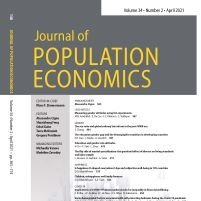 Journal of Population Economics
Journal of Population Economics